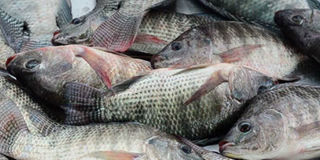Keeping fish

I am an upcoming farmer. I am interested in aquaculture, kindly advise me which fish to go for. Isaac
Dear Isaac
Central, eastern and West Nile regions have high potential for aquaculture since the regions are endowed with natural water sources such as rivers, streams, wetlands and springs, among others.
Furthermore, the relatively warmer temperatures found in these areas makes it possible to grow fish and harvest within the recommended time-frame.
You can go for both Nile tilapia and African catfish which have shown good growth in the areas. Alternatively, you can opt for monoculture of either tilapia or catfish.
Market surveys have shown the presence of both the two species being sold by fish vendors.
Before you start, I advise you visit the fisheries department at the Ministry of Agriculture to seek services on site selection, pond construction, acquisition of fingerlings and management practices.
Alternatively, you can seek these services elsewhere but ensure professionalism.
Answered by Alex Akidiva, AgroScience Park Fish farm, Egerton University.
Switching from cane to cabbage
I am a sugarcane farmer and I want to shift to cabbage growing. Kindly guide me on how to start and which variety can do better. John Othieno
Dear John
There are many cabbage varieties and they include Gloria F1, Riana F1, Copenhagen market, Golden acre, Queen F1, Serena F1 and others. You can try Gloria F1.
Propagation and establishment: Cabbage is propagated through seeds. They are sowed in the nursery bed and later transplanted after three to four weeks to rows 60-75cm apart and 45-60cm within the rows.
Wider spacing (75x60cm) is usually adopted for late maturing cultivars (up to 130 days) and closer spacing (60x45cm) for early maturing cultivars (up to 55 days). Head size can be regulated by plant density. Direct seeding followed by thinning is not normally successful in the tropics.
Preferable, remove seedlings separately, never pull as this may damage feeding roots.
Fertilisers: Cabbage is a heavy feeder of nitrogen and potassium. Organic matter, phosphatic and potasic fertilisers should be applied before transplanting and dressing of N fertilisers applied about four weeks from transplanting and three weeks thereafter.
Rates are 5-10g/plant (185-370kg/ha) of CAN and 200kg/ha DSP. Cabbage benefits from heavy doses of well decomposed organic manure but there is need for balanced application of NPK. Excess nitrogen application alone results in loose puffy heads, which do not store well.
Weed control: Cabbage is shallow rooted and care should be taken not to damage roots in the field as this would encourage entry of fungi and bacteria.
Cabbage is also a poor competitor of weed thus it should be protected from weeds. Avoid excessive weeding as it may lower yields due to more water loss through evapotranspiration and root damage.
Mulching: It may be beneficial in weed control, among other advantages like helping in water retention.
Irrigation: Irrigation should be done whenever necessary. It is important to note that cabbage is relatively shallow-rooted, thus may need regular watering if rainfall is not adequate. Critical water requirement stage for cabbage is at head formation.
Answered by Carol Mutua, Department of Crops, Horticulture and Soils, Egerton University.
Milk value addition
I need your advice on how a small scale milk farmer can do value addition.Joseph
Dear Joseph
As a dairy producer, you can add extra value to your milk by processing and marketing your own products, such as cheeses, bottled milk, yoghurt, ice cream or butter.
Value-added products can help your farm become more viable, earning high income.
However, there are more risks involved when selling value-added versus marketing directly to your local milk cooperative.
When considering the production and marketing of value-added dairy products, you have to take into consideration the capital, time commitment and market share.
Some important questions to ask yourself:
What product do you intend to sell?
Who is your target audience and how will I market the product?
Are my location(s) convenient to the consumer?
What is the profit potential of the product?
How much will the consumer pay for the product?
How will I demonstrate the quality of the product?
Answered by Caroline Makau, Department of Dairy, Food Science and Technology, Egerton University
Milling plant
Thank you for Seeds of Gold. Thanks to your dedicated team, my Saturdays will always be bright.
I’m interested in starting up a milling plant in my area. It will be processing maize meal, dairy meal and chicken feed.
I would like to know the availability and the cost of a machine that will be able to do this. JP Epolon
Dear JP Epolon
To have a milling plant you require a three-phase power line and a steady supply of raw material. You may also need to consult an animal nutritionist to formulate the various rations for you.
Answered by Dr Mary Ambula of Egerton University.




